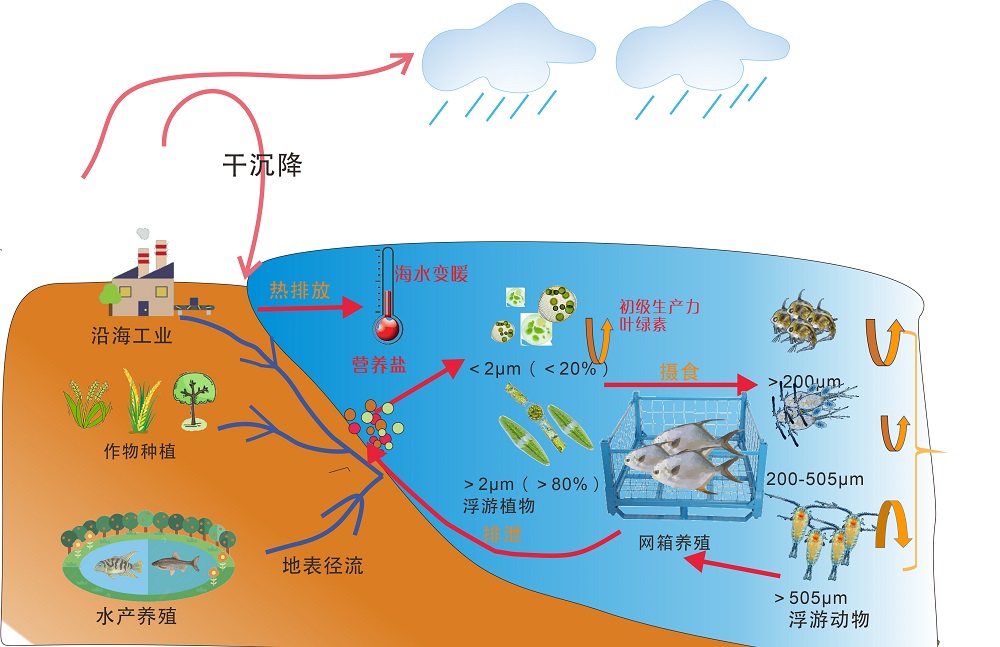News
The Gulf is one of the most important areas that carry natural changes and human activities. Its environmental degradation will cause ecosystem degradation and resource decline, which has negative feedback on the social economy. As a typical subtropical bay ecosystem in China, Xiangshan Harbor in Zhejiang Province has unique topography, hydrodynamics and biological communities. The response of its ecosystem to human activities and natural changes is an important feedback to the development pattern of harbor space units.
A few days ago, the offshore ecology research team of the Key Laboratory of Marine Ecosystem Dynamics of the Ministry of Natural Resources took, Xiangshan Harbor, the long and narrow semi-enclosed bay of the East China Sea, as the research area, and systematically revealed the evolution pattern of plankton in the bay under the superimposed influence of eutrophication and seawater warming. Relevant results have been published in international mainstream journals on oceanographic and plankton such as Marine Pollution Bulletin, Estuary and Coast, Estuary, Coast and Continental Shelf, and Plankton Research.
The study has found that a large amount of phytoplankton biomass in the eutrophic bay cannot be effectively transferred to high-trophic organisms. Biomass refers to the total weight of a certain type of organism per unit area (volume). Phytoplankton is the primary producer of photosynthesis, and high-trophic organisms are zooplankton and fish that prey on phytoplankton in the food chain.
The research team used the simultaneous multi-parameter high-density sampling method and the random forest model to find that the biomass of zooplankton in Xiangshan Harbor does not increase with the increase of phytoplankton biomass, and the ratio of them decreased with the increase of phytoplankton biomass, indicating a large amount of phytoplankton energy cannot be effectively transferred to high-trophic organisms through the food chain. The study has also found that zooplankton is most sensitive to warming. The increase in temperature promotes the increase of zooplankton in small individuals (small and medium-sized, 200~505 microns), while the number of larger individuals (>505 microns) decreases, that is, the zooplankton tends to miniaturization as a whole, which makes it impossible for larger individual phytoplankton biomass to be transferred to high-trophic organisms through zooplankton feeding.
The study has found that the long-term evolution of plankton in the subtropical narrow bay shows temporal and spatial heterogeneity. The temporal and spatial heterogeneity means that biological and abiotic environment changes with time and is unevenly distributed in space. Xiangshan Harbor is a subtropical narrow and semi-enclosed bay. The physical and chemical environment and biological community have significant seasonal changes and spatial heterogeneity. Based on this, the research team speculates that the long-term changes of nutrients, water temperature, and plankton may also have temporal and spatial heterogeneity, and verifies the hypothesis with historical data from 1980 to 2019.

Historical evolution of the planktonic ecosystem in Xiangshan Port
The research team integrates physical and chemical factors and the long-term changes and heterogeneity characteristics of various trophic organisms to deduce the evolution process of the bottom plankton ecosystem in Xiangshan Harbor: eutrophication and warming increase the phytoplankton biomass, especially the growth of diatoms and dinoflagellates, but the warming of sea water is not conducive to the reproduction of large zooplankton, resulting in the lack of effective feeding control of large-diameter phytoplankton; the warming of sea water in winter accelerates the growth of phytoplankton, and the feeding effect of plankton in the same period is weaker, causing the algal bloom to intensify with the algal bloom time advanced from spring to winter. The primary productivity generated by phytoplankton flourishing cannot be effectively transmitted to the higher trophic zooplankton and fish, resulting in reduction in the efficiency of the grazing food chain. Therefore, in addition to overfishing, changes in the size structure and phenological process of plankton caused by the increase of eutrophication and warming are also important reasons for the significant decline of fishery resources in Xiangshan Harbor compared with the 1980s. In addition, the relative importance of the micro-food loop as a supplementary pathway for the transmission of primary productivity may increase, and the impact of its changes on the efficiency of energy transfer needs to be studied.



